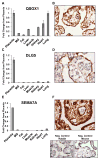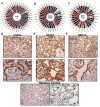A comprehensive analysis of the human placenta transcriptome
- PMID: 24333048
- PMCID: PMC3978120
- DOI: 10.1016/j.placenta.2013.11.007
A comprehensive analysis of the human placenta transcriptome
Abstract
As the conduit for nutrients and growth signals, the placenta is critical to establishing an environment sufficient for fetal growth and development. To better understand the mechanisms regulating placental development and gene expression, we characterized the transcriptome of term placenta from 20 healthy women with uncomplicated pregnancies using RNA-seq. To identify genes that were highly expressed and unique to the placenta we compared placental RNA-seq data to data from 7 other tissues (adipose, breast, hear, kidney, liver, lung, and smooth muscle) and identified several genes novel to placental biology (QSOX1, DLG5, and SEMA7A). Semi-quantitative RT-PCR confirmed the RNA-seq results and immunohistochemistry indicated these proteins were highly expressed in the placental syncytium. Additionally, we mined our RNA-seq data to map the relative expression of key developmental gene families (Fox, Sox, Gata, Tead, and Wnt) within the placenta. We identified FOXO4, GATA3, and WNT7A to be amongst the highest expressed members of these families. Overall, these findings provide a new reference for understanding of placental transcriptome and can aid in the identification of novel pathways regulating placenta physiology that may be dysregulated in placental disease.
Keywords: Development; Fetal tissue; Gene expression; Pregnancy; RNA-seq.
Copyright © 2013 Elsevier Ltd. All rights reserved.
Figures



Similar articles
-
Transcriptome landscape of the human placenta.BMC Genomics. 2012 Mar 27;13:115. doi: 10.1186/1471-2164-13-115. BMC Genomics. 2012. PMID: 22448651 Free PMC article.
-
Discrete placental gene expression signatures accompany diabetic disease classifications during pregnancy.Am J Obstet Gynecol. 2025 Mar;232(3):326.e1-326.e15. doi: 10.1016/j.ajog.2024.05.014. Epub 2024 May 17. Am J Obstet Gynecol. 2025. PMID: 38763341
-
RNA-seq analysis of the functional compartments within the rat placentation site.Endocrinology. 2012 Apr;153(4):1999-2011. doi: 10.1210/en.2011-1833. Epub 2012 Feb 21. Endocrinology. 2012. PMID: 22355068 Free PMC article.
-
Current approaches and developments in transcript profiling of the human placenta.Hum Reprod Update. 2020 Nov 1;26(6):799-840. doi: 10.1093/humupd/dmaa028. Hum Reprod Update. 2020. PMID: 33043357 Free PMC article. Review.
-
Placental transcriptome in development and pathology: expression, function, and methods of analysis.Am J Obstet Gynecol. 2015 Oct;213(4 Suppl):S138-51. doi: 10.1016/j.ajog.2015.07.046. Am J Obstet Gynecol. 2015. PMID: 26428493 Review.
Cited by
-
A Comprehensive Assessment of Associations between Prenatal Phthalate Exposure and the Placental Transcriptomic Landscape.Environ Health Perspect. 2021 Sep;129(9):97003. doi: 10.1289/EHP8973. Epub 2021 Sep 3. Environ Health Perspect. 2021. PMID: 34478338 Free PMC article.
-
The Role of Sphingolipid Metabolism in Pregnancy-Associated Breast Cancer After Chemotherapy.Biomedicines. 2024 Dec 13;12(12):2843. doi: 10.3390/biomedicines12122843. Biomedicines. 2024. PMID: 39767749 Free PMC article.
-
A genome scale transcriptional regulatory model of the human placenta.Sci Adv. 2024 Jun 28;10(26):eadf3411. doi: 10.1126/sciadv.adf3411. Epub 2024 Jun 28. Sci Adv. 2024. PMID: 38941464 Free PMC article.
-
Genome-wide identification of transcriptional enhancers during human placental development and association with function, differentiation, and disease†.Biol Reprod. 2023 Dec 11;109(6):965-981. doi: 10.1093/biolre/ioad119. Biol Reprod. 2023. PMID: 37694817 Free PMC article.
-
Circulating RNA Transcriptome of Pregnant Women with TSH Just Above the Trimester-Specific Reference and its Correlation with the Hypertensive Phenotype.Sci Rep. 2020 Apr 15;10(1):6439. doi: 10.1038/s41598-020-63040-5. Sci Rep. 2020. PMID: 32296081 Free PMC article.
References
-
- Sitras V, Paulssen RH, Gronaas H, Vartun A, Acharya G. Gene expression profile in labouring and non-labouring human placenta near term. Mol Hum Reprod. 2008;14(1):61–5. - PubMed
Publication types
MeSH terms
Substances
Grants and funding
LinkOut - more resources
Full Text Sources
Other Literature Sources
Research Materials
Miscellaneous

